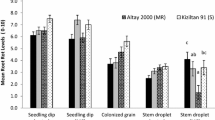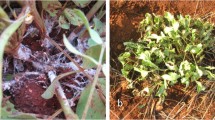Abstract
Field evaluation of six cassava genotypes for resistance to root rot disease was compared with three rapid laboratory methods (whole root inoculation, root slice inoculation, and stem inoculation) for resistance screening. Both the field evaluation and the three laboratory methods separated the varieties into resistant and susceptible groups. Genotypes 30572 and 91/02324 were resistant while 92/0247, 92/0057 and TME-1 were susceptible. One genotype (30001) was not consistent in its reaction between field evaluation and laboratory assays. In the laboratory assays with three fungal pathogens, different pathogens varied in their levels of virulence on host genotypes. With the most virulent pathogen (Botryodiplodia theobromae), the majority of the genotypes reacted in the same way across trials with the root slice and whole root assays. Due to the good correlation between the whole root assay and the field results, we recommend this for the routine assessment of cassava resistance to root rot disease and for the analysis of virulence of pathogen isolates. However, because of the advantages in terms of economy of labour, space, time, quantity of root and inoculum required, the root slice assay could be used for the preliminary screening of large cassava accessions. The selected genotypes can then be further screened with the whole root inoculation method.
Similar content being viewed by others
References
Akinyele B, Ikotun T. Micro-organisms associated with cassava tuber rot. IITA Root tuber and plantain improvement programme Annual Report IITA Ibadan Nigeria, 1988: 16– 18.
JT Ambe (1994) ArticleTitleEffect of harvesting time on cassava fresh root yield in Cameroon Discov Innovat 6 IssueID3 315–317
Barragan MI, Alvarez E, Loke JB, Llano GA. Identificacion de fuentes de resistencia a la pudricion radical de yuca (Manihot esculenta Crantz). Paper presented at ASCOLFI, held at Pastto, Colombia, May 29, 1998.
B Boher A Ptcholo B Tchabama (1997) ArticleTitleIdentification of the factors enhancing the occurrence of an unusual stem and root rot in cassava in Togo.Cultural practices are accused. Cah - Rec Dev 43 52–58
Booth RH. A review of root rot diseases in cassava. In: Brekelbaum T, Bellotti A, Lozano JC, eds. Proceeding of Cassava Protection Workshop held at CIAT, Cali, Colombia, 7– 12 Nov 1977. Centro Internacional de Agriculture Tropical (CIAT) Series CE-14, 1978: 121– 133.
InstitutionalAuthorNameCentro Internacional de Agricultura Tropical. (1987) Cassava Programme Annual Report 1986 Cali Colombia
InstitutionalAuthorNameCentro Internacional de Agricultura Tropical. (1990) Cassava Programme Annual Report 1989 Cali Colombia
U Darsow (1987) ArticleTitleLong term results of a tuber slice test for relative resistance to late blight Potato Res 30 IssueID1 9–22 Occurrence Handle10.1007/BF02357680
OD Dhingra JB Sinclair (1986) Basic plant pathology methods CRC Press Inc. Florida, USA
AE Dorrance DA Inglis (1988) ArticleTitleAssessment of laboratory methods for evaluating potato tubers for resistance to late blight Plant Dis 82 IssueID4 442–446
LJ Dowley E O’Sullivan HW Kehoe (1991) Development and evaluation of blight resistant potato cultivars JA Lucas RC Shattock DS Shaw LR Cooke (Eds) Phytophthora Cambridge University Press Cambridge 372–381
CN Fokunang AGO Dixon T Ikotun CN Akem EA Tembe (2002) ArticleTitleRapid screening method of cassava cultivars for resistance to Colletotrichum gloeosporioides f.sp. manihotis Phytopathology 150 6–12 Occurrence Handle10.1046/j.1439-0434.2002.00708.x
Forest Practices Code. Host susceptibility and symptomology. In: Root Disease Management Guidebook. Forest Practices Code of British Columbia Act, 1995. www.for. gov.dc.ca/legsregs/fpc/fpcguide/root/roottoc.htm.
SK Hahn RL. Theberge (1987) Technique and advances in breeding cassava for disease resistance in Africa CH Hersey (Eds) Proceedings of a Workshop held in the Philippines Centro Internacional de Agricultura Tropical Cali,Colombia 312
InstitutionalAuthorNameIITA. (1990) Cassava in Tropical Africa. A Reference Manual International Institute of Tropical Agriculture (IITA) Ibadan 176
C Lopez JC Lozano (1992) ArticleTitleEvaluation of resistance to Phytophthora nicotianaeit var. nicotianae in cassava (Manihot esculenta Crantz) Fitopatol Col 16 113–119
NH Mahungu AGO Dixon JM Kumbira (1994) ArticleTitleBreeding cassava for multiple pest resistance in Africa Afr Crop Sci J 2 IssueID4 539–552
W Msikita B James E Nnodu J Legg K Wydra F Ogbe (2000) Disease Control in Cassava Farms IPM Field Guide for Extension Agents IITA Ibadan,Nigeria 27
W Msikita JS Yaninek M Ahounou H Baimey R Fagbemisi (1997) ArticleTitleFirst report of Nattrassia mangiferae root and stem rot of cassava in West Africa Plant Dis 81 IssueID11 1332
JE Parlevliet (1993) What is durable resistance, a general outline T Jacobs JE Parlevliet (Eds) Durability for Disease Resistance Kluwer Academic Publishers Dordrecht 23–39
Peever TL, Zeigler RS, Dorrance AE, Correa-Victoria FJ, St. Martin S. Pathogen population genetics and breeding for disease resistance. APSnet Feature Story July 2000.
SAS Institute. SAS System for Windows. User’s guide version 8. NC, USA Cary 2000.
RL Theberge (Eds) (1985) Common African Pest and Diseases of Cassava, Yam, Sweet Potato and Cocoyam IITA Ibadan,Nigeria
Author information
Authors and Affiliations
Corresponding author
Rights and permissions
About this article
Cite this article
Onyeka, T.J., Dixon, A.G.O. & Ekpo, E.J.A. Assessment of laboratory methods for evaluating cassava genotypes for resistance to root rot disease. Mycopathologia 159, 461–467 (2005). https://doi.org/10.1007/s11046-004-6156-z
Received:
Revised:
Issue Date:
DOI: https://doi.org/10.1007/s11046-004-6156-z




